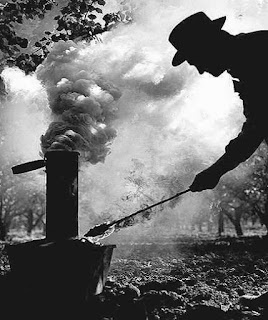From one of my previous layouts I had a very simple building
flat that was constructed from two wall sections of a Butler-style metal building
made by Rix Product's Pikestuff Division. It probably was from their Distribution Center
While Butler-style metal buildings are quite common today,
there were very few of these around in 1956, the year that I model. I do have
one such building on the layout, the Sanford & Son Truck Salvage Company.
Sanford & Son Truck Salvage Company
I
really didn't want another Butler
Kit-Bashed Welding Shop
The simple building flat, with its
very obvious Butler
The sign on the building indicates that it is the Scheu
Manufacturing Company. As I know now, this simple model in no way resembles either
of the real Scheu buildings in Upland
Scheu Manufacturing Company: The Original Complex
The young inventor's device garnered tremendous success and by
1920 he had purchased a former packing house in Upland California , this simple device
would protect citrus groves throughout Southern California and much of the
western United States
Original Smudge Pot Design & Cleaner Burning Return Stack Heater
Machinery Arrives At Upland (Notice Reefer At Rear Of Photo)
Scheu initially operated a complex at 297 and 255 Stowell Street Upland Second Avenue Santa Fe tracks from the Upland depot. The current Scheu office is located at 177 D Street Upland and is the former Upland City Hall
Inside The Scheu Factory
Current Scheu Office
As used in California Los Angeles Basin
Smoke & Fire
Wind Machine
















No comments:
Post a Comment